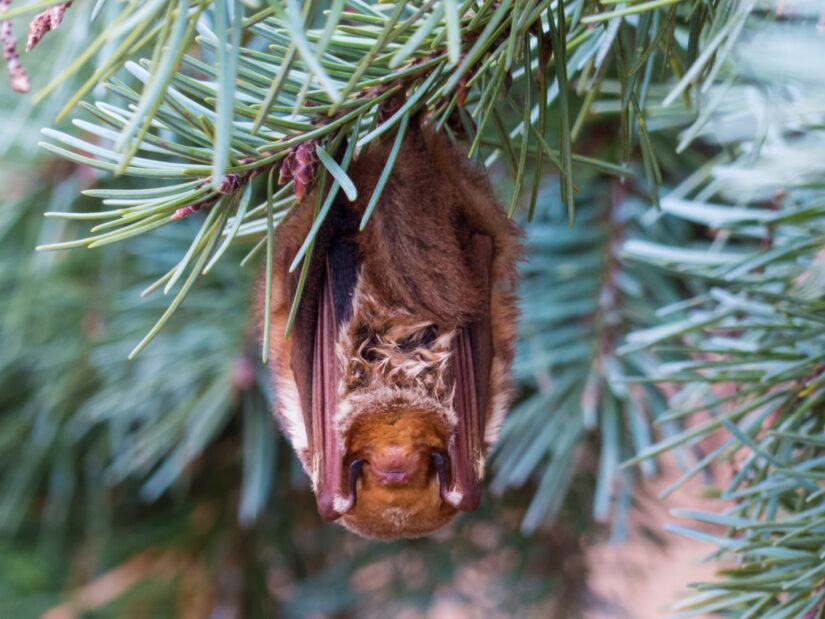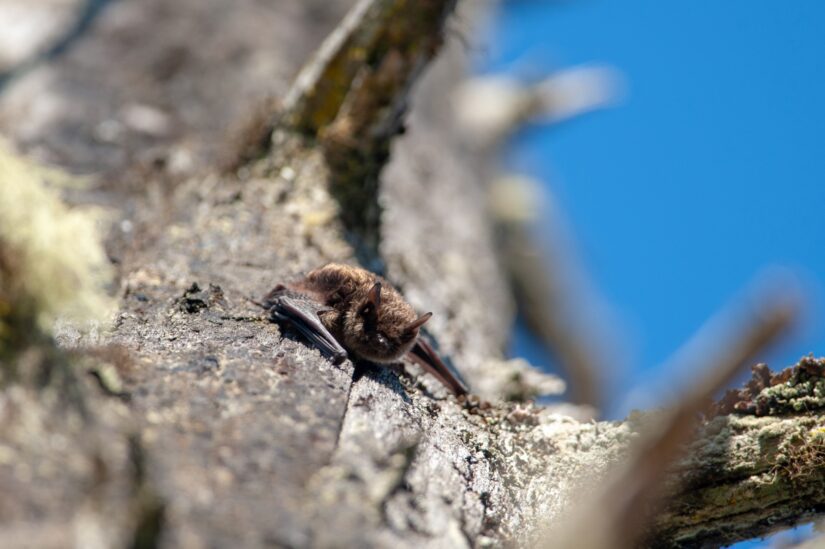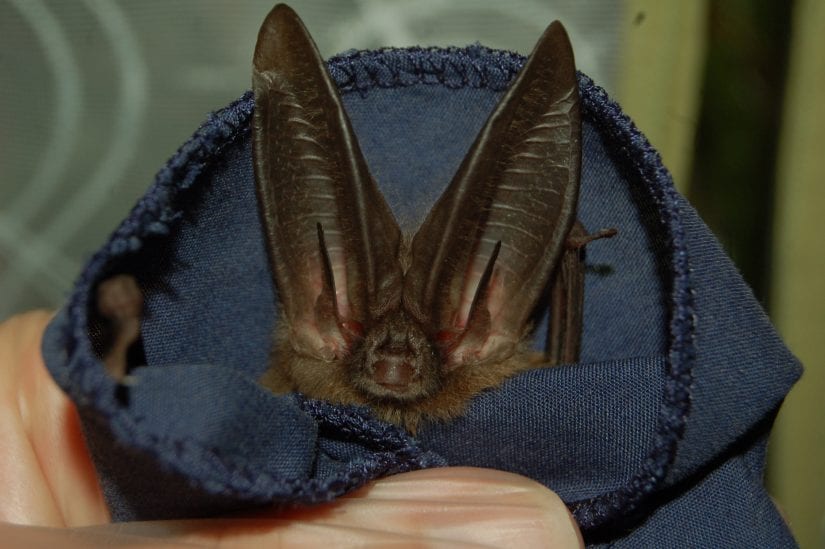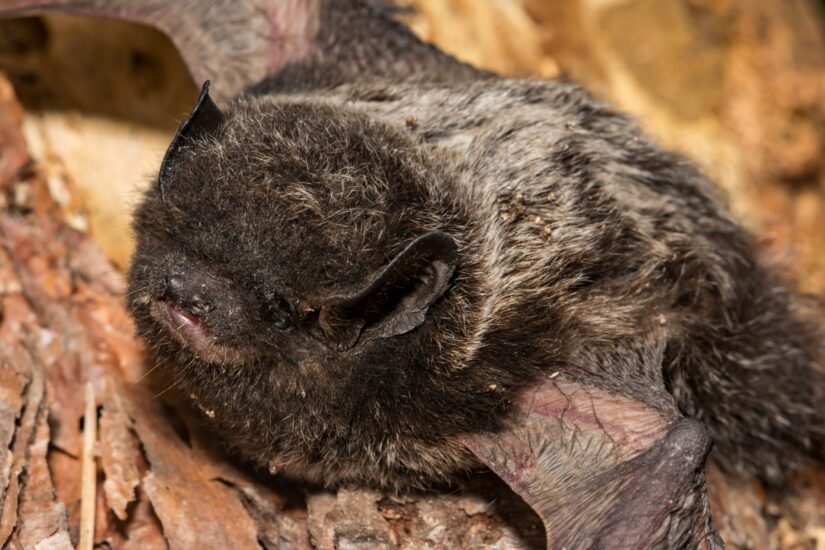Despite being a critical part of our ecosystems, bats are far from being universally adored. Perhaps this is why they tend to be missing from conversations about the impacts of cats on wildlife. Yet, just like birds, bats are vulnerable to cat predation. Read on to find out why, and what you can do to make your home and community more bat-friendly.

Bats are good for us
There are around 1,400 known species of bats in the world, making them the second most common group of mammals next to rodents. Although much about bats is still a mystery to us, we do know that they perform valuable ecosystem services as pollinators, seed dispersers and insect predators. In Canada, our bat species only eat bugs — mainly insects and spiders.
Bats in B.C.
B.C. has the greatest diversity of bats in Canada, with 15 of the country’s 19 species calling our province home. Because of their nocturnal lifestyle, it can come as a surprise to some that bats are among the most common wildlife in our cities. They’re drawn to river valleys and parks where they can find sources of water and old trees to roost in. Human-made structures like barns and houses are also attractive as roosting sites, especially for little brown bats.

Bats are in trouble
Sadly, bats are among the most endangered animals in the world, facing threats from habitat loss, pesticides, diseases, introduced predators, climate change and outright persecution. Here in B.C., half of our bat species are at risk. They need our help to protect them — and, as pet guardians, we can start with our cats.
Cats are a threat to bats
A recent analysis of wild animal intake and health data from across Canada revealed that cat attacks are the greatest source of trauma for bats. In 2022, a B.C. study also found that cats were the most frequent cause of death for bats submitted to the provincial veterinary laboratory.
Cats are swift and agile hunters. They can see well at night when bats are most active and can hear the high frequency sounds used by echolocating bats. Cats tend to hunt bats either by sitting on their hind legs and catching them in the air with a swat of their paws or by leaping and catching them in mid-air.
Even if bats manage to escape a cat attack, they can still be fatally injured. Cats can easily tear their delicate wing membranes, which impacts their ability to fly. Also, the bacteria carried on cats’ teeth and claws can be transferred through scratch and puncture wounds and cause a deadly infection.

What makes bats so vulnerable to cats?
Bats are vulnerable to cat predation because of their behaviour and their biology.
Bat behaviour. Bats are social animals and like to roost together in groups. The noise, smell and movement associated with these roosts can attract cats, who often lie in wait for the bats as they emerge at night to feed. Some roosting spots that bats choose, such as attics, can make them more likely to encounter cats.
Bat biology. Bats are long-lived animals with low reproductive rates. Most bats give birth to just one pup each year, and only about half of pups make it through their first winter. Studies have revealed that cats tend to prey on healthy bats rather than ones who are already weak or vulnerable. Evidence also exists that female bats are attacked more often than male bats. Taken together, this can further impact a population’s ability to compensate for cat predation and other threats.
The rabies risk
Bats are the only known wild carrier of rabies in B.C. Although rabies occurs at very low levels in bat populations — about one in every thousand bats — being outdoors puts cats at risk. In fact, a Canadian study found that compared to indoor cats, free-roaming cats had a ten-fold higher interaction rate with bats and double the probability of encountering a rabies-positive bat. This also puts other animals and people whom the cat comes into contact with at risk too.

Protecting bats from cats
Given that hunting is a natural behaviour for cats, the most effective way to prevent them from harming bats is to keep them indoors, particularly at night when bats are most active and during the reproductive season (March to August) to protect females and their young. Once cats learn the location of a roost, they often return to it night after night, so keeping your cat inside could save a whole colony.
For guardians who live near forested areas, keeping cats indoors is especially critical. Research has shown that the probability of a cat preying on native species increases closer to forest edges. Bats tend to target areas with higher concentrations of insects, which can include forest edges where insects seek shelter from the wind. This can bring them into contact with cats on the hunt.
For cats who still want a taste of outdoor life, supervising them outdoors or providing them with outdoor access in an enclosure like a catio is a safe alternative. The BC SPCA also has plenty of tips for keeping indoor cats entertained.
Other ways to help bats
In addition to protecting bats from cats, here are some other things you can do to help our nighttime neighbours:
- Plant native trees, shrubs and flowers to attract insects. Moths are an especially important food source for bats. For those with limited space, potted plants and hanging baskets are a good option.
- Avoid using pesticides.
- Come fall, avoid raking up all your leaves. Decaying plant matter makes great shelter for overwintering insects that will benefit bats the following spring.
- Light pollution impacts how bats hunt. Keep your yard or garden dark at night to encourage use by foraging bats.
- Watch out for signs of White-nose syndrome, a fungal disease that has devastated bat populations across North America, and report sightings of dead bats or unusual bat activity to the B.C. Community Bat Program.
- There is still so much that we don’t know about bats. The more we learn, the better we can protect them! Take part in a citizen science project for bats in your local community.
